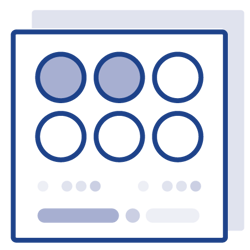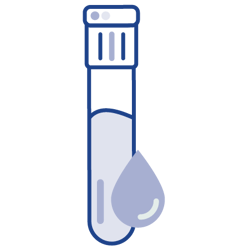7 min read
Fecal Zonulin - What does it tell us?
What is Zonulin?
Zonulin, used in conjunction with other fecal inflammation markers such as calprotectin, can help...
IgG, IgA, and IgG4 immunoglobulin testing for up to 240 food markers
Food sensitivities are inflammatory responses of the immune system triggered by food allergens. Unlike food allergies, the symptoms of a food sensitivity often occur hours or even days after exposure, making it difficult to pinpoint the specific offending food(s). This delayed reaction is what causes the majority of the 12 million people estimated to suffer from food sensitivities unaware and blame things like aging for their chronic symptoms.
Food sensitivity testing streamlines the process of identifying triggering foods, providing clear evidence and guidance to begin the healing process and start improving symptoms.
When testing for food sensitivities, US BioTek uses three main immunoglobins, IgG (1,2,3), IgA, and IgG4. We test these antibodies separately to establish a clear picture of what food triggers may be the root cause of patients’ symptoms.
IgG is an antibody that can activate the pro-inflammatory complement system (complement cascade) associated with chronic inflammatory conditions. High levels of IgG (class II or higher) overload receptors and drive the inflammatory reaction while low levels of IgG (class 0/I) indicate tolerance.
IgG food sensitivity testing is the most commonly performed food sensitivity testing and foods that are only high in IgG can often be safely re-introduced after a period of abstinence.
IgG4 is an antibody which in most people does not activate the complement system, but instead is a “blocking antibody” for IgE. The presence of IgG4 is protective, not inflammatory, as IgG4/IgE binding tends to decrease IgE hypersensitivity (true allergy). If IgG4 is high, testing for IgE reactivity is advised and it may be best to remove the food from the diet permanently.
Independent increases in IgG4 only can be associated with certain autoimmune conditions such as eosinophilic esophagitis.
IgA is an antibody that can activate the pro-inflammatory complement system. Unlike Secretory IgA (sIgA) in stool, which is two IgA molecules bound together and secreted into the gut, serum IgA levels are associated with allergies and asthma. A Serum IgA reaction to food triggers can indicate foods that are irritating the lining of the gut.
Food and cuisine create a beautiful foundation for cultures around the world. Depending on regionality, ethnicity, personal preferences, and more, the foods that make up an individual's diet can vary greatly. To ensure our practitioners have access to food panels that fit the diets of their patients and address as many relevant antigens as possible, US BioTek has developed eight unique panels so each patient can utilize the best food sensitivity test for their needs.

Our food sensitivity panels utilize a quantitative ELISA (enzyme linked immunosorbant assay) analysis of the specific immunoglobin(s) IgG, IgA, and IgG4 identified for the chosen diet panels’ food and spice analytes.
We follow a meticulous process to extract the critical component from each analyte (food trigger) to ensure the antibody present in the patients’ sample will bind properly and validate results with positive and negative controls. Once attached to the antigens, antibodies are detected through spectrophotometric analysis, where the values are directly proportional to the concentration of the analytes in the sample. For additional accuracy, we perform duplicate testing to ensure there are no discrepancies.
More information on testing methods for food sensitivities >>


The dried blood spot collection method utilizes a simple finger prick and collection card. This method is ideal drop shipping to telehealth patients and clinics without venipuncture capabilities.

The serum collection method requires a modest blood draw.
Apr 23, 2024by Dr. Andrea Gruszecki, ND
Zonulin, used in conjunction with other fecal inflammation markers such as calprotectin, can help...
Mar 13, 2024by Dr. Andrea Gruszecki, ND
Why do some children have problems with IgE allergy as infants? A history of IgE-mediated allergic disorders in infancy...
Jan 24, 2024by US BioTek Marketing Department
There are many ways a body can demonstrate an aversion to specific foods, with allergies, sensitivities and...
Yes, all general and vegetarian food sensitivity panels come with Candida Albicans as an analyte marker. The 96 Asian and 96 Japanese panels do not include this marker.
No. We encourage all patients to consume their regular diet leading up to their food sensitivity and fasting prior to specimen collection is not required.
An elimination diet is a process of removing offending foods from your diet for a length of time to allow the body and immune system to heal. Following the elimination of the foods for the given period, foods with moderate sensitivity can be reintroduced on a 4-day rotation.
Providers can view and download results through our secure Clinician Portal, or request results by email.
Please note that US BioTek does not discuss test results directly with patients. Practitioners assume the responsibility of relaying test results to their patients. All results are confidential.
Test kits are available to registered providers upon request. Use our online submission form to order the collection kits you require.
Easy collection and low volume specimen requirements are advantages of the US BioTek testing methodology. Follow our simple instructions.
Upon completion of specimen collection, complete our test requisition form and include it in your specimen shipment.
Providers can view and download results through our secure Clinician Portal, or request results by email.
Please note that US BioTek does not discuss test results directly with patients. Practitioners assume the responsibility of relaying test results to their patients. All results are confidential.